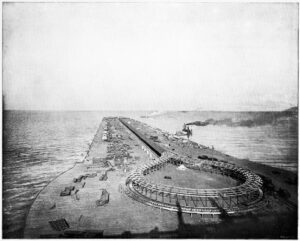Exhibition of the works exhibited at “World’s Columbian Exposition, Chicago”
After enjoying the “Fugen Bosatsu” displayed in Room 2 on the 2nd floor of the Tokyo National Museum (Tohaku) Main Building, I went down to the 1st floor and checked the exhibition of “Neil’s salvage” that I visited the other day. And I looked at Tadataka Ino’s map, then headed to the large room where exhibits for the 1893 Chicago World Exposition were lined up.
Here, more than 10 pieces of crafts made for export during the Meiji period that were exhibited at the Chicago World Exposition in 1893, are displayed.
The 1893 Chicago World Exposition was called the “Chicago-Columbus World Exposition” in Japan at the time. The 1893 Chicago World Exposition was held to commemorate the 400th anniversary of the arrival of the American Continent by Columbus. As is often the case with World Expositions, delays in preparation caused that the event would not take place on the 400th anniversary of 1892, but a year later.
“White City”, “Ferris Wheel”, and “Moving Sidewalk”
Chicago was hit by a great fire in 1871, and this World Exposition was also meant to commemorate the recovery from that fire. The venue was Jackson Park, about 8 miles south of the city center. Fire-resistant bricks, stones, and iron are used in the venue, and the architecture incorporates ancient Greek and ancient Roman architectural styles.
Due to the whiteness of the architecture, the Expo Site was called the “White City“.

「ホワイト・シティ」と呼ばれた万博会場
Expo Site called “White City”
The Chicago Expo was also a hit with the world’s first 80-meter-tall Ferris Wheel, and the “Moving Sidewalk” operated by Edison’s General Electric Company.

大観覧車(フェリス・ホィール)
FerrisWheel

グレート・ウォーフの「動く歩道」
The Great Wharf, ’Moving Sidewalk’
19 countries participated in the 1893 Chicago World Exposition, one of which was Japan.
According to the “Expo Secretariat Report“, the Minister of Agriculture and Commerce was supposed to be the President of the Expo Secretariat.
In order of appointment, Munemitsu Mutsu → Toshikama Kono → Tsunetami Sano → Shojiro Goto → Takeaki Enomoto are listed as presidents. I wonder if you can somehow get a sense of the times.
In addition, Tadamasa Hayashi, Kihachiro Okura, Kentaro Kaneko, and Eiichi Shibusawa are among the “Councilors” of the Expo Secretariat.
Arts of East and West from World Expositions
In fact, as part of the 2005 Aichi Expo, the 2005 Japan Association for the World Exposition cosponsored the Special Exhibition consisted of works of art that were exhibited overseas from Japan, and of works of European artists who were involved also in World Expositions in the 19th century.
Arts of East and West from World Expositions
1855-1900 : Paris, Vienna and Chicago
The exhibition was held from July 2004 to March 2005.
There were three venues: the Tokyo National Museum, the Osaka Municipal Museum of Art, and finally the Nagoya City Museum, in the same prefecture of the site of the Expo.
It was an exhibition in which I was involved as part of my job. This exhibition focused on Japanese arts exhibited at World Expositions in the 19th century, as well as European painters who were involved in those World Expositions (Delacroix, Ingres, Courbet, Manet, etc.) . The two groups of exhibits were introduced in one exhibition.
This ” Arts of East and West from World Expositions” exhibition also introduced some of the works exhibited at Tohaku that I visited this time.
For example,
Kawanobe Iccho “Cosmetic Box with a Wisteria and Peony“

川之辺一朝『藤牡丹蒔絵手箱』
Kawanobe Iccho “Cosmetic Box with a Wisteria and Peony
or
Kenjiro Kaneda “Hawk”

金田兼次郎『牙彫鷹置物』
Kaneda Kenjiro “Hawk”
Kinkozan Sobei VII “Jar with a Pair of Phoenixes”

七代錦光山宗兵衛
『色絵金襴手鳳凰文飾壺』
Kinkozan Sobei VII
“Jar with a Pair of Phoenixes”
And then there’s the huge plate, Seiji Kaisha’s ” Large Dish with Flowers and Birds.”

『色絵花鳥文大皿』精磁会社 1893年
“Large Dish with Flowers and Birds”
Seiji Kaisha Company, 1893

『色絵花鳥文大皿』(裏面)精磁会社 1893年
“Large Dish with Flowers and Birds”
(Back) Seiji Kaisha Company, 1893
All of these works were exhibited at the 1893 Chicago-Columbus World Exposition by the Chicago-Columbus World Exposition Secretariat.
According to the explanation of this exhibition, it says about this last “Seiji Kaisha” as follows;
*
Seiji Kaisha was a porcelain manufacturing company founded in 1879 by Suminosuke Fukami, Kamenosuke Tezuka, Katsuzo (Tsuneaki) Tsuji and others after they quit Koransha.
*
This “Koransha” is still a prestigious Arita ware company. They also have a store in Ginza, Tokyo.
According to the Koransha website, it says;
“About 300 years ago, around the time of the Genroku era, when Edo culture flourished, Eizaemon Fukagawa first started manufacturing porcelain, at the predecessor of Koransha, in Arita, Hizen.
And during the turbulent period of the Meiji Restoration that brought modernization to Japan, Arita ware lost all protection and support from the Saga Nabeshima clan. Eizaemon Fukagawa VIII played a leading role in its revival.
A strong spirit of independence brought together the best potters, painters and merchants of the time to form an association. This is Koransha. ”
Also, the book “Meiji Arita Transcendence Beauty” (supervised by Yukio Suzuta), says;
“Koransha was founded in April 1875 by Suminosuke Fukami, Katsuzo Tsuji, Kamenosuke Tezuka, and Eizaemon Fukagawa 8th. It is the earliest ceramic manufacturing and sales company in Japan.”
“Due to differences in management policies, the company was separated in 1879 to establish Seiji Kaisha, and in July of the same year, Koransha restarted under the sole management of Fukagawa Eizaemon.”
It is likely that this platter was produced by this separate Seiji Kaisha and exhibited at the Chicago World’s Fair.
Seeing this gigantic work in front of me made me feel that this platter had traveled all the way to Chicago and surprised people all over the world. I think about the hardships of various people behind it, including those who were involved in producing this Dish, and the people of Expo Secretariat.

展示風景
Exhibition View



